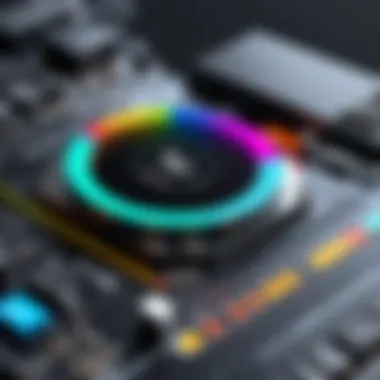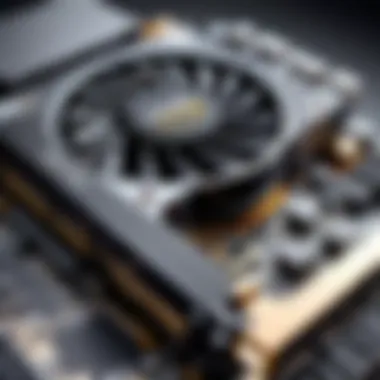Mastering PC Graphics Testing: A Comprehensive Guide


Intro
In the evolving landscape of computer technology, graphics performance plays a crucial role in enhancing user experiences. Understanding the intricacies of PC graphics testing is essential for tech enthusiasts, gamers, and professionals alike. This guide will explore various methodologies and benchmarks used to assess graphics capabilities. Furthermore, it addresses the factors influencing graphical performance, the importance of stress testing, and how these evaluations can shape consumer technology choices.
Key Features
Graphics performance is influenced by several key characteristics of graphic processing units (GPUs) and other components. The following subsections provide detailed insights into the critical features that contribute to overall performance.
Design and Build Quality
The design and build quality of a graphics card significantly impact both performance and longevity. High-end models often feature advanced cooling solutions, which are essential for maintaining optimal temperatures under heavy workloads. Brands like NVIDIA and AMD invest in innovative designs that allow for efficient heat dissipation, enabling sustained performance during intensive tasks.
Additionally, premium materials contribute to durability and strength. A well-constructed GPU can withstand the rigors of prolonged use. Reviews often highlight the importance of solid construction, as users prefer models that do not bow under pressure.
Display and Performance
Display technology is another critical component in assessing graphics capabilities. Performance is typically evaluated using frame rates, resolutions, and refresh rates. For instance, a GPU capable of rendering 4K visuals at high frame rates provides a superior experience in gaming and content creation.
Furthermore, technologies like G-Sync and FreeSync enhance visual fluidity, reducing screen tearing and stuttering. The synergy between the GPU and the display is essential, as it directly influences overall performance.
Product Specifications
When evaluating graphics performance, several technical specifications must be considered. The details outlined below can provide insights into a GPU's capabilities and compatibility with other components in a system.
Technical Specifications
Some of the critical specifications of GPU include:
- CUDA Cores: More cores typically allow for better parallel processing of graphical tasks.
- VRAM: A higher amount of VRAM facilitates smoother gameplay, especially in high-resolution scenarios.
- Clock Speed: The operating frequency of the GPU can affect rendering times and performance under load.
Compatibility and Connectivity
Compatibility with existing hardware is vital. Most GPUs utilize PCI Express slots, but ensuring compatibility with the motherboard and other components is crucial before purchase. Additionally, connectivity options such as HDMI and DisplayPort can affect external monitor connections.
Compatibility and connectivity can significantly influence the performance and functionality of graphics cards in a PC setup.
Prolusion to PC Graphics Testing
Evaluating the performance of a computer's graphics capabilities is vital in today's tech-centric world. Understanding and implementing graphics testing helps ensure that systems can handle demanding applications like gaming, 3D rendering, and data visualization. This section will elucidate the key aspects of graphics testing and its central role in maintaining high-performance computing.
Defining Graphics Testing
Graphics testing is the process of assessing a computer's graphical performance through various methodologies, tools, and benchmarks. It involves measuring aspects such as frame rates, rendering quality, and resource usage, which are critical for determining how well a graphics processing unit (GPU) operates under different scenarios.
Using a range of tests, from synthetic benchmarks to real-world simulations, developers and enthusiasts can obtain a comprehensive understanding of a GPU’s capabilities and limitations. This not only helps in ensuring that the hardware meets expectations but also plays a significant role in product development and innovation.
Importance of Graphics Performance
The performance of graphics hardware is fundamental in defining the overall user experience, particularly in gaming and professional applications. High graphic performance translates to smoother visuals, higher resolutions, and improved responsiveness. Achieving optimal graphics performance is important for several reasons:
- User Experience: High frame rates and graphics settings directly affect how immersive and enjoyable an application or game can be.
- Competitive Edge: For gamers, consistent high performance can mean the difference between winning and losing in competitive environments.
- Hardware Compatibility: Understanding a system's graphics performance involves ensuring compatibility with various software applications. This is crucial for both gamers and professionals who rely on specific toolsets for their work.
- Future-Proofing: As software continues to evolve, higher graphical demands will surface. Conducting regular graphics testing helps ensure a system remains relevant and capable of handling demanding future applications.
"Regular graphics testing is not just about current performance but also about anticipating future needs."
The significance of graphics testing extends beyond assessments; it is a proactive measure that can save users from future performance issues. High-performance graphics are a necessity in a world driven by visual content, where every detail counts.
Key Components of Graphics Performance
Understanding the key components of graphics performance is essential for anyone involved in PC graphics testing. Knowing how various elements function together can significantly impact both gameplay experience and software performance. Each component contributes uniquely to the overall output and efficiency of graphical tasks, making it imperative to grasp the nuances of GPU architecture, VRAM role, and cooling systems.
Understanding GPU Architecture


The architecture of a Graphics Processing Unit (GPU) is fundamental to its performance capabilities. It refers to the organization of core components that dictate how the GPU processes data. Modern GPUs are built with numerous cores, allowing them to handle many tasks simultaneously. This parallel processing capability makes GPUs highly effective for rendering graphics and performing complex calculations.
- Key features of GPU architecture include:
- Core Count: More cores generally enhance performance in graphics-intensive applications, as the GPU can split tasks and process them simultaneously.
- Clock Speed: Higher clock speeds result in quicker data processing but also may lead to increased power consumption.
- Shader Units: These are specialized cores that perform computations on graphics’ visual elements. The number and efficiency of shader units greatly affect rendering speed.
Understanding these elements allows users to make educated decisions when selecting components for gaming or professional use. Poorly matched architectures can bottleneck performance, leading to underwhelming experiences.
The Role of VRAM
Video Random Access Memory (VRAM) plays a crucial role in graphics performance, particularly in rendering high-quality images. VRAM stores textures, graphics data, and animations that the GPU needs to access rapidly.
- Primary functions of VRAM include:
- Storage of Textures: High-resolution textures require substantial VRAM. If insufficient, the system may resort to slower system RAM, degrading performance.
- Frame Buffering: VRAM holds the frame data before it is displayed, enabling smoother visuals.
- Reduces Latency: As VRAM is dedicated to graphics tasks, it minimizes the delay in data retrieval, leading to better frame rates.
The amount of VRAM affects all graphical tasks, especially in modern gaming and creative applications. More VRAM generally translates to better performance, especially at higher resolutions.
Impact of Cooling Systems
Cooling systems are often overlooked but equally important in maintaining optimal graphics performance. A well-functioning cooling system ensures that the GPU operates within optimal temperature ranges, preventing thermal throttling. When a GPU overheats, it reduces its performance to cool down, which can adversely affect gaming or rendering tasks.
- Considerations for cooling systems include:
- Air vs. Liquid Cooling: Air cooling is simpler and sufficient for many users, while liquid cooling can handle more intense workloads.
- Fan Design: More efficient fans can improve airflow, leading to lower temperatures.
- Thermal Paste Quality: The type and application of thermal paste can impact heat transfer between the GPU and its cooling solution.
An effective cooling system prolongs component lifespan and ensures consistent performance. This is vital for users committed to high-performance graphics applications.
"Understanding the key components of graphics performance empowers users to make informed decisions, maximizing the capabilities of their systems and enhancing overall experience."
Types of Graphics Tests
Understanding the types of graphics tests is crucial for evaluating the performance and reliability of graphics processing units (GPUs). Different graphics tests serve various purposes, from benchmarking and stress testing to real-world performance assessments. Each test type offers insights into GPU capabilities, assisting users in making informed technology choices.
Benchmark Tests Explained
Benchmark tests are standardized metrics used to measure the performance of a GPU under controlled conditions. These tests typically evaluate how well a graphics card handles specific tasks, such as rendering graphics or processing complex algorithms. Common benchmarks include software like 3DMark, Heaven Benchmark, and Unigine Valley. They simulate real-world scenarios, providing the results that can be compared across different hardware configurations.
One key advantage of benchmark tests is their ability to provide quantifiable data, allowing users to see clear differences in performance. Most benchmarks also come with predefined settings, ensuring consistency in testing. This relevance is especially valuable for gamers and professionals seeking to maximize their system's capabilities, as they can easily determine which components offer the best performance for their needs.
Stress Testing for Stability
Stress testing is essential for understanding the durability and reliability of a GPU. This type of test pushes the hardware to its limits, running it at maximum load for extended periods. The intention is to determine how the GPU behaves under conditions that are more demanding than typical use. Stress tests reveal not only performance metrics but also stability issues such as overheating or throttling.
Programs like FurMark and Prime95 serve as popular tools for stress testing. During these tests, monitoring software can track temperatures, clock speeds, and power consumption. Users should pay close attention to these metrics, as they can signal potential hardware failures or the need for cooling system upgrades. Unlike standard benchmarks, stress testing focuses more on the resilience of the hardware rather than just its speed.
Real-World Performance Testing
Real-world performance testing examines how well a GPU performs in practical applications, such as gaming or content creation. Unlike synthetic benchmarks, this method uses actual software applications to evaluate performance. Games like "The Witcher 3" or software like Adobe Premiere are common choices for this type of testing.
It is essential to observe not only frame rates but also factors like input lag, visual quality, and overall experience. By testing under various settings, one can gauge how a GPU handles specific workload requirements. Real-world performance tests help the user understand if a particular GPU will meet their needs in daily use scenarios, making it indispensable for potential buyers.
"Understanding the various types of graphics tests can significantly impact your purchasing decisions, ensuring you invest in the right technology for your needs."
Essential Tools for Graphics Testing
Graphics testing is a profound aspect of assessing PC performance, and utilizing the right tools can dramatically enhance accuracy and efficiency. The tools outlined in this section serve as the backbone for a successful testing strategy. Employing these tools ensures that tests are conducted systematically, providing reliable data for analysis.
Popular Benchmarking Software
Benchmarking software is crucial for gauging the performance potential of graphics hardware. This type of software simulates various workloads that a graphics processing unit (GPU) would encounter in real-life applications. Popular tools include:
- 3DMark: This software is widely used to compare the performance of GPUs across different systems. It runs a series of tests, producing scores that reflect the graphical capabilities.
- FurMark: Known for its rigorous stress testing capabilities, FurMark pushes the GPU to its limits, allowing users to identify potential overheating and stability issues.
- Unigine Heaven: This tool benchmarks the graphical performance through realistic environments, providing visual stress tests and real-world scenarios.


By using benchmarking software, users can make informed decisions about their hardware investments and identify performance bottlenecks that might affect overall system functioning.
Monitoring Tools and Software
Monitoring tools provide real-time data to track the performance of graphics hardware during testing. They are essential for identifying issues that may not be evident from benchmark scores alone. Key tools include:
- MSI Afterburner: This powerful tool monitors GPU temperatures, clock speeds, and fan speeds while also enabling overclocking features. It offers an in-depth view of the GPU's operating parameters.
- HWMonitor: A lightweight program that tracks the temperature and power consumption of various components, ensuring efficient performance and longevity during extended graphic loads.
- GPU-Z: This software provides detailed information on the GPU specifications, such as memory type and manufacturing process, which helps in understanding performance limits.
Using these monitoring tools allows users to observe how well their setup can sustain performance during both benchmarking and real-world applications. It also aids in fine-tuning components for optimal performance.
"Employing thorough testing methodology, combined with reliable tools, ensures accurate measurement of graphical performance across all workloads."
Graphics Testing Methodology
Graphics testing methodology is crucial for accurately assessing the performance and capabilities of graphics processing units. This section will delve into the significance of setting up a controlled environment, as well as the parameters involved, to ensure that the test results are reliable. This systematic approach allows for consistency and reproducibility in testing, which is essential when comparing different GPUs or when evaluating upgrades.
Setting Up Testing Parameters
Establishing precise parameters is the foundation of effective graphics testing. This involves defining the conditions under which the tests will be conducted. Key elements include:
- Resolution: This determines the amount of detail processed by the GPU. Common resolutions such as 1080p, 1440p, and 4K can significantly impact performance metrics.
- Frame Rate Target: Setting a target frame rate helps establish expectations for smooth gameplay. This can vary based on the type of game being tested.
- Quality Settings: These include texture quality, shadow detail, and anti-aliasing levels. Adjusting these settings enables a comprehensive assessment of how the GPU handles various graphic loads.
- Testing Duration: A standardized testing duration allows for consistent results. Typically, running a benchmark for several minutes gives more reliable average performance figures.
By carefully defining these settings, testers can minimize external variables that could skew the results, ensuring that the assessment focuses solely on the GPU's capabilities.
Conducting Controlled Experiments
After parameters are set, it is essential to conduct experiments under controlled conditions to ensure the validity of results. Adhering to a strict methodology includes:
- Isolation of Variables: Avoid changes during testing that could affect performance. It is important to keep the same hardware configuration throughout the tests to get accurate comparisons.
- Use of Benchmarking Tools: Tools like 3DMark or Unigine Heaven are often utilized to standardize tests and gather data effectively. Such software provides detailed reports on performance metrics.
- Ambient Conditions: Ensure that the testing environment is stable. Factors such as room temperature should be controlled, as extreme conditions can affect thermal performance.
- Multiple Runs: Conducting several test runs helps average out any anomalies in the measurements. Typically, running a test three times and averaging the results provides a reliable data set.
- Documentation of Results: Keeping detailed records of each test will allow for insightful analysis, facilitating comparisons and trend evaluations in the future.
By following these methodological steps, evaluators enhance the reliability and credibility of their graphics testing results. This ensures that findings can be trusted by both consumers and industry professionals alike.
Interpreting Graphics Test Results
Interpreting graphics test results is crucial in the realm of PC graphics testing. Data from tests helps users understand the capabilities and limitations of their graphical systems. Furthermore, it aids in making informed decisions when upgrading components for better performance.
Many factors play a role in the interpretation of results. One must consider not only raw data like frame rates but also how these numbers translate into user experience. Context is important. Data without context can lead to misleading conclusions. For instance, a high frame rate does not always mean a superior gaming experience unless other elements are also taken into account.
To gain the most benefit from graphics test results, it is vital to analyze different parameters. This analysis aids in identifying bottlenecks and deciding if upgrades or adjustments are necessary. Moreover, it ensures users fully utilize their hardware's potential.
"Understanding graphics test results is not just about numbers; it's about understanding what those numbers mean for real-world applications."
Understanding Frame Rates
Frame rates refer to how many frames are displayed each second during gaming or any graphics-heavy task. This measurement is commonly expressed in frames per second (FPS). Higher frame rates contribute to smoother gameplay, which enhances the overall experience. Generally, 60 FPS is seen as a baseline for fluid gaming. Anything above this can improve responsiveness significantly.
However, frame rates alone are not enough. Other factors, such as input lag and rendering techniques, also impact performance. Understanding the nuances of FPS allows users to better judge their system's capabilities and choose games or applications that match their hardware.
Metrics Beyond Frame Rates
Beyond frame rates, several key metrics can paint a more comprehensive picture of graphics performance:
- Minimum Frame Rate: This indicates the lowest FPS during a test. A high minimum helps ensure consistent performance, which is often more critical than average frame rates.
- Frame Time: This measures how long a single frame takes to render. Lower frame times lead to smoother visuals. High variability can cause stuttering, disrupting immersion.
- Resolution: The graphical resolution directly affects the performance output. Higher resolutions demand more from the hardware. Understanding your system’s rendering capability at different resolutions is essential.
- V-Sync Performance: Vertical Synchronization can help eliminate tearing but might limit frame rates to the monitor’s refresh rate. This can create a trade-off between smooth visuals and high FPS.
Incorporating these metrics into the analysis of graphics test results allows you to form a holistic view of your system's performance. By doing so, users can tailor their settings to achieve optimal results, ensuring a more satisfying experience.
Common Challenges in Graphics Testing
Graphics testing can uncover a multitude of insights regarding performance, but it also presents several challenges. Understanding these challenges is crucial for anyone looking to achieve accurate and reliable results. This section outlines common difficulties faced during the graphics testing process, examining hardware limitations and software compatibility issues.
Hardware Limitations
Hardware plays a vital role in the accuracy of any graphics test. One of the primary limitations arises due to older or less powerful graphic processing units (GPUs). These GPUs may not support the latest graphical technologies, which limits the ability to test modern gaming or rendering scenarios. As a result, benchmarks may display skewed results, suggesting higher performance than actually possible in real-world applications.


Additionally, power supply constraints can affect performance. If a GPU does not receive enough power, it will throttle its performance to avoid damage. This throttling can lead to misleading benchmark scores. Hence, ensuring that your system's hardware is capable and compatible is key to obtaining credible performance data.
Another significant hurdle is related to variations in systems. Differences in RAM speeds, motherboard compatibility, and cooling solutions all contribute varying levels of performance impact. Each of these factors may cause discrepancies when comparing test results across different setups. To mitigate these issues, consistently conducting tests on similar hardware configurations is recommended.
Software Compatibility Issues
Software compatibility is equally critical in the realm of graphics testing. Various operating systems and driver versions may introduce unique behaviors in software applications and games, affecting test outcomes. For instance, the Diffusion of DirectX or Vulkan API updates across different software can influence graphics performance metrics.
Moreover, specific applications may contain bugs that lead to unanticipated results, causing the test results to vary widely from expectation. Having the latest drivers installed is essential but can sometimes create new issues. There can be unforeseen instabilities introduced in new driver versions, particularly when paired with older hardware.
Updating the game or benchmark software is another necessary step but carries a risk. Each update may include optimizations or fixes that alter performance, making it challenging to maintain a consistent baseline for comparison.
A thorough understanding of these challenges allows testers to prepare adequately, ensuring better and more accurate testing outcomes.
Overall, identifying these limitations and compatibility issues can help in refining the graphics testing process. As technology advances, recognizing and addressing these challenges becomes increasingly important for achieving reliable performance evaluations and informing consumer choices.
Future Trends in Graphics Performance Testing
Understanding future trends in graphics performance testing is crucial. As technology advances, so does the need to evaluate how graphic systems perform under new conditions and demands. This section will explore how emerging technologies and machine learning significantly shape the landscape of graphics testing. These developments promise enhanced performance metrics and more accurate evaluations.
Emerging Technologies
Emerging technologies in graphics processing express a notable shift in how performance is tested. For instance, the advent of Ray Tracing has fundamentally changed visual realism in gaming. Traditionally, graphics testing focused on frame rates and resolution, but now evaluating Ray-Traced graphics requires different metrics to assess their impact on performance.
Furthermore, developments in virtualization, such as NVIDIA's CloudXR, can allow users to run graphics-intensive applications using cloud computing, generating a need to test performance through different bandwidth conditions. Real-time rendering and the demands for higher fidelity visuals require benchmarking tools that adapt to these innovations.
Some key technologies to watch include:
- Next-gen GPUs that prioritize AI processing
- High Bandwidth Memory (HBM) for enhanced data transfer speeds
- Advanced cooling solutions to manage increased thermal outputs
These technologies not only enhance performance but also introduce complexities in graphics performance testing, necessitating new approaches and methodologies.
The Evolving Role of Machine Learning
Machine learning is making headway into graphics performance testing, improving efficiency and accuracy. Algorithms can analyze vast datasets generated during testing, allowing for rapid identification of performance bottlenecks and optimization opportunities. Moreover, machine learning models can predict how a certain graphics card will perform based on parameters like temperature, load, and user settings.
The incorporation of AI capabilities such as real-time adaptive rendering further exemplifies the evolution. This technology allows for automatic adjustments made while a game runs, which could lead to significant performance improvements without manual intervention by the user.
Key benefits of embracing machine learning in graphics testing include:
- Increased testing speed through automated processes
- Enhanced predictive capabilities for performance analysis
- Ability to identify less obvious performance issues that manual testing might overlook.
Machine learning tools will be pivotal in future graphics testing, enabling a more dynamic understanding of performance in various scenarios.
Adopting emerging technologies and machine learning in graphics performance testing is inevitable for maintaining relevance in a rapidly evolving industry.
The End
In the realm of PC graphics testing, the conclusion encapsulates the essence of the entire discussion. This section emphasizes the critical importance of graphics performance testing as a vital aspect for anyone engaged in technology and gaming. Consumers often rely on the insights gained from comprehensive tests to make informed purchasing decisions and optimize their systems.
Summarizing Key Points
The significant components of graphics performance, such as GPU architecture, VRAM, and cooling systems, have all been discussed in detail. Understanding benchmark tests, stress tests, and real-world performance evaluations provide clarity on how a graphics card performs under various conditions. Tools like popular benchmarking software and monitoring tools have also been highlighted.
In summary, the major points discussed can be categorized as follows:
- Key Components of Performance: GPU, VRAM, cooling systems.
- Types of Tests: Benchmarking, stress tests, and real-world evaluations.
- Essential Tools: Benchmarking software and monitoring applications.
- Challenges Faced: Hardware limitations and software compatibility.
- Future Outlook: Emerging technologies and machine learning's role in graphics testing.
Conclusion urges readers to consider these factors holistically while assessing their graphic computing needs.
Implications for Consumers
The implications of the content discussed in this article extend beyond mere academic insights. Understanding the intricate details of graphics testing allows consumers to make choices that align with their specific needs. A gamer may prioritize frame rates and real-time performance, while a content creator might focus on superior processing capabilities and stability under load.
Key considerations for consumers include:
- Balancing performance requirements with budget constraints.
- Recognizing the potential impact of future technologies on current investments.
- Staying informed about the evolving landscape of graphics performance tools and benchmarks.
In general, informed consumers will have a better grasp of what distinguishes good graphics performance from great, thus better equipping themselves for making smart purchasing decisions.



